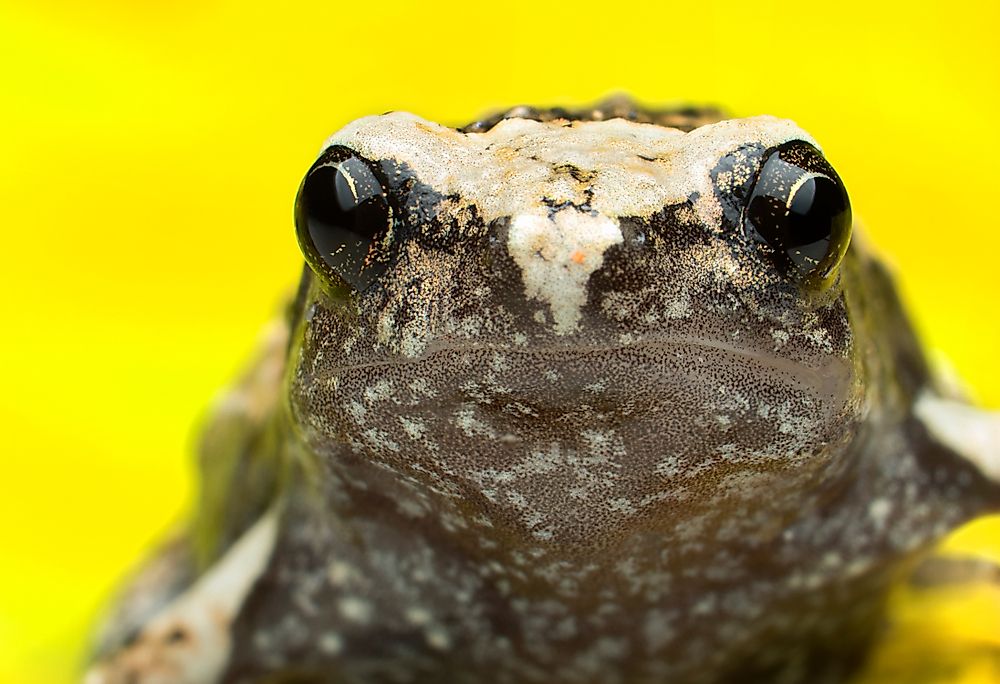Native Amphibians Of The Philippines

Palawan Eastern Frogs and Smooth-Skinned Forest Frogs are, like many Philippine amphibians, both endemic and threatened. Another endemic species living in the tropical rainforests of the country is the Basilan Island Caecilian, which is known only from the type locality on Basilan Island. The widely distributed Painted Narrowmouth Toad is not endangered, but it is native to the country’s forests biome and degraded forest fringes. Because of the many islands in the archipelago country species experience restricted ranges and reproductive patterns couple tightly to the local micro-climates. As a result, many amphibian species are poorly known. So far the biodiversity conservation remains an on-going effort, and significant challenges include logging, conversion of natural habitats to agricultural lands, and rapid development of the human population.
Palawan Eastern Frog (Alcalus mariae)
The Palawan Eastern Frog (Alcalus mariae) is a species in the Ceratobatrachidae Family endemic to the Island of Palawan. The Palawan Eastern Frog is known from the type of locality it inhabits in Mount Balabag in the mountain range of Mantalingajan. Alcalus mariae is a stocky frog around 32 millimeters in length, with a depressed, broad head and a rounded snout. It has a visible tympanum. The digits are disk-tipped, webbed toes with disc tips, while the legs are stout and relatively short. Their natural habitat is in the lower montane forests probably breeding on land by direct development, just as other members of the genus do. The most significant threats facing the Palawan Eastern Frog are habitat loss and habitat conversion for agriculture. Even though the Mantalingajan mountain range is well protected, some areas are still prone to selective logging.
Smooth-Skinned Forest Frog (Platymantis levigata)
The smooth-skinned forest frog is a species in the Ceratobatrachidae Family, and is also endemic to the Philippines. The species occurs in the rainforests of Tablas, Sibuyan, and Romblon Islands at an elevation of 800 or 900 meters above sea level. The species shows a direct development reproduction. The female lays eggs in forests habitats such as on leaves, twigs, branches, and moss. Continuing habitat loss from small-scale logging and clearing of lowland rainforests for agriculture purposes are the primary threats. The most important conservation approach needed at present is the protection of the remaining rainforests of Romblon and Tablas. The population on the Island of Sibuyan is well protected.
Basilan Island Caecilian (Ichthyophis glandulosus)
The Basilan Island Caecilian (Ichthyophis glandulosus) is an amphibian species in the Icthyophiidae Family. The species is endemic to the Philippines preferring to live in the tropical and subtropical moist lowland forests, tropical or subtropical moist Montane forests, freshwater springs, rivers, intermittent streams, near plantations, irrigated lands, seasonally flooded farms and rural gardens, and in heavily degraded former forests. The species biology is only known from the type locality on Basilan Island. The species is presumably oviparous with terrestrial eggs, aquatic larvae that inhabit the unpolluted rivers, streams, and quiet pools, and the adult are subterranean. Little information on threats to this species is known, but habitat loss resulting from pollution of water bodies or deforestation could impact on the species population.
Painted Narrowmouth Toad (Kaloula picta)
The Painted Narrowmouth Toad (Kaloula picta) is a frog species belonging to the Microhylidae Family, and is endemic to the Philippines. It prefers to live in tropical or subtropical moist lowland forests, tropical or subtropical moist shrubland, tropical or subtropical flooded or seasonally wet grasslands, freshwater lakes and marshes, rivers, intermittent streams, wetlands and lakes, arable lands, plantations, and water storage areas such as ponds. The species is a burrowing frog with small toe disks. They surface during the rainy season to breed in pools on the ground. The tadpoles are pigmented. The species is not subject to significant threat, and the population trend is stable. However, a possible threat is competition from invasive species and predation. Since the species can live in disturbed lands conservation in protected areas is not necessary
Conservation of Philippine Amphibians
With such an excellent array of biodiversity, the Philippines have become a primary focus in the zoological world, with a vast number of new and endemic species discoveries in the recent years establishing the country as a biodiversity hot spot. The herpetological diversity of the native amphibians in the rainforests of the Philippines is incredible. As such the country needs to monitor these species to assess the significant challenges facing them and their response to the conversion of their habitats to agricultural lands, resource extraction, introduction of new species and habitat degradation.
Native Amphibians Of The Philippines
| Native Amphibians of the Philippines | Binomial Scientific Name |
|---|---|
| Palawan Eastern Frog | Alcalus mariae |
| Woodworth's Frog | Limnonectes woodworthi |
| Basilan Island Caecilian | Ichthyophis glandulosus |
| Smooth-Skinned Forest Frog | Platymantis levigata |
| Leyte Slender Stream Frog | Hylarana albotuberculata |
| Rabor's Forest Frog | Platymantis rabori |
| Tagibo Wart Frog | Limnonectes diuatus |
| Painted Narrowmouth Toad | Kaloula picta |
| Malatgan River Caecilian | Caudacaecilia weberi |
| Kalinga Narrowmouth Toad | Kaloula kalingensis |











